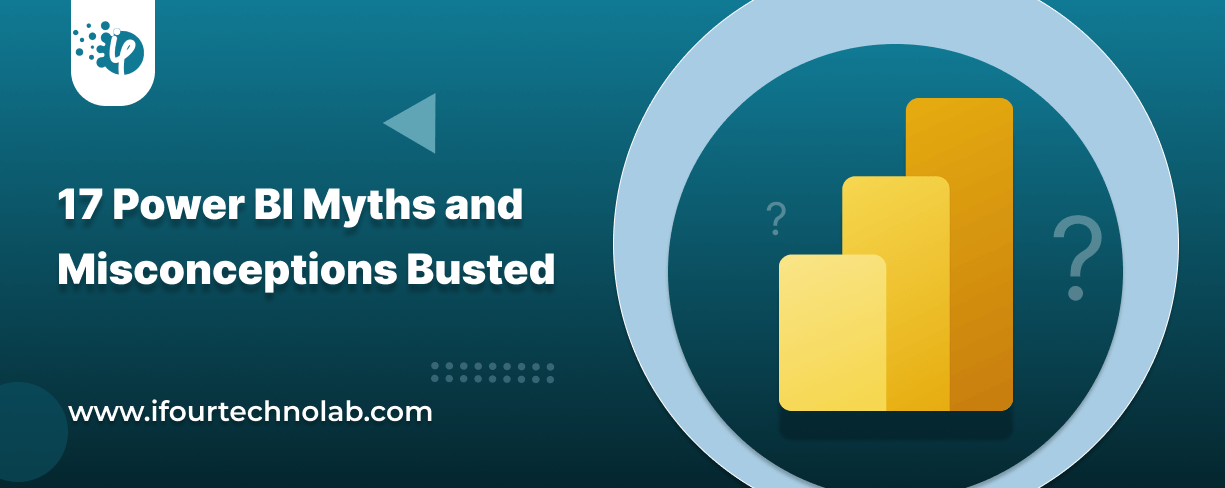17 Power BI Myths and Misconceptions Busted | Uncover the Truth
Did you know that 70% of CTOs (Chief Technology Officers) hesitate to adopt Microsoft Power BI because of its myths and misconceptions that float around. What they fail to see is...
Kapil Panchal - June 23, 2022
Listening is fun too.
Straighten your back and cherish with coffee - PLAY !

Big data is exactly what its name states, ‘big’ ‘data.’ Various people, tools, and machines produce dynamic, enormous, and divergent volumes of data; this data collection is called big data. To collect, host, and analyze such large amounts of data, a new, innovative, and scalable technology is required.
The core premise of the term big data is that everything we do leaves a digital trail that we can utilize and analyze to grow wiser. Access to ever-increasing amounts of data and our ever-increasing technical capabilities to mine that data for commercial insights are the driving factors in this new tech world. According to a report, annual revenue from the global big data analytics market is expected to reach 68.09 billion U.S. dollars by 2025.
It is extremely difficult to describe data engineering accurately. It entails planning and constructing the data infrastructure required to gather, clean, and format data to be accessible and usable to end-users. Data engineering goes hand-in-hand with data science; additionally, it is also referred to as a continuation of software engineering.
As data processing gets increasingly complicated, data engineering skills are evolving. It is also an essential step in the hierarchy of data science requirements: without data engineers' architecture, analysts and scientists won't be able to access or work with data. And as a result, corporations risk losing access to one of their most precious assets. To cope with such concerns organizations should integrate Big Data Analytics with .NET development or any other platform.
An excellent example of this said evolution is data transformation, which is now more than just 'warehousing' and ETL (extract, transform, load) activities.
Though the core role has been there for a long time, the term "data engineer" only became popular in the last decade. This occurred in tandem with the rise of data-driven services such as Facebook. We required new data transformation technologies to extract relevant business information as more real-time user data sources came. Since then, data engineering has taken off and hasn't looked back. It's now one of the most sought-after designations in the era of big data.
While big data engineers aren't recognized for generating groundbreaking discoveries, no one would be able to use data unless they worked their magic, putting it into a format that everyone can understand. An experienced data engineer can provide the groundwork and even give reliable basic reports and models.
The most common responsibilities of a big data engineer include:
The tasks of data scientists and data engineers have a lot of similarities. However, the positions have different priorities and require diverse knowledge at their core. A data scientist is usually well-versed in statistics, predictive modeling, and machine learning.
On the other hand, a data engineer usually has a computer science background. The engineer will be at ease with relational and non-relational databases, data warehousing, and various data distribution strategies. They also use technologies like Hadoop, Spark, and Airflow to make data extraction, transfer, and loading (ETL) more efficient and automated.
Together, they complement each other very well and form the foundation of a very well-established company.
A data engineer's primary responsibility is to build a data pipeline that consistently and efficiently delivers relevant data for analysis. All types of user logs, user data, customer support requests, and external data sources are available to modern businesses. It's a tremendous problem to transform all that data into something usable. Creating effective methods for transmitting and storing big datasets is a non-trivial challenge considering that they can include millions of records.
To make data more useful and valuable, it must be cleansed, consolidated, connected to other data, and enhanced with external information. When the data is ready, it may be used to create dashboards and aid decision-making.
A thorough understanding of software architecture and distributed systems is required to design data pipelines and storage infrastructure that can manage big data.
A crucial component of a data engineer's job involves a lot of development. This entails gathering, storing, and disseminating data within an organization. As a result, data engineers frequently begin their careers as software developers.
ETL (Extract, Transform, Load) tools are a collection of technologies that move information from one system or infrastructure to another. They basically let users take data from a variety of sources, condense it into new forms (transform), and then move it to a new database or system.
ETL can be performed using computer languages such as Python or commercial tools like Xplenty or Talend, which are created expressly for the purpose.
An excellent big data engineer should be well-versed with database languages and tools. Python is the most widely used data science programming language, owing to its simplicity, versatility, and significant community engagement. Java and R are two other popular examples. Database knowledge (SQL and NoSQL in particular) is also required.
This is a crucial aspect of a data engineer's job, and it necessitates familiarity with a variety of valuable technologies. Apache Spark is an open-source framework and analytics engine for analyzing large data sets from a variety of sources. Hadoop is another important tool for distributing the processing of massive data volumes over several machines. It's frequently used in conjunction with Hive, an Apache-based data warehouse infrastructure tool.
According to a report by Domo, we will be producing 165 zettabytes of data per year by 2025. As a result, more and more companies are investing in big data and AI technologies to manage unstructured data. It helps companies to make well-informed decisions and improve metrics such as customer satisfaction, customer retention, organizational efficiency, revenue, etc.
To achieve this, companies must hire talented data engineers, data scientists, AI/ML engineers, etc., to derive valuable insights from raw data and drive business growth.

Did you know that 70% of CTOs (Chief Technology Officers) hesitate to adopt Microsoft Power BI because of its myths and misconceptions that float around. What they fail to see is...

Every CTO knows the struggle of managing complex reports. The inefficiency of scattered data, the constant juggling between reporting tools, the challenge of ensuring accurate KPIs...

The very first reason why you should implement Row Level Security is to foster trust, a crucial element for any business's success. Next, it reduces data clutter and helps you load...